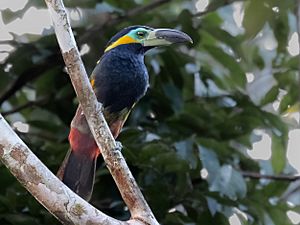Golden-collared toucanet facts for kids
Quick facts for kids Golden-collared toucanet |
|
|---|---|
 |
|
| Male | |
 |
|
| Female | |
| Conservation status | |
| Scientific classification | |
| Genus: |
Selenidera
|
| Species: |
reinwardtii
|
| Subspecies | |
|
See text |
|
 |
|
| Range of S. r. reinwardtii | |
| Synonyms | |
|
|
The golden-collared toucanet (Selenidera reinwardtii) is a colorful bird from the toucan family. It lives in parts of South America, including Bolivia, Brazil, Colombia, Ecuador, and Peru. These birds are known for their bright colors and unique bills.
Contents
Types of Golden-collared Toucanets
Scientists recognize two main types, or subspecies, of the golden-collared toucanet. These are S. r. reinwardtii and S. r. langsdorffii.
Sometimes, people treat these two types as separate species. They even have different nicknames! One is called the "red-billed" toucanet, and the other is the "green-billed" toucanet. Even though they have different names, these two types can still breed together where their homes overlap in Peru.
What Golden-collared Toucanets Look Like
Golden-collared toucanets are about 33 to 35 centimeters (13 to 14 inches) long. They weigh between 129 and 200 grams (4.5 to 7 ounces). Both types of toucanets look very similar in their feathers.
Adult males have a black head, neck, and shoulders. A thin yellow band separates their black shoulders from their green back. Their tail is green with brownish tips on some feathers. Around their eyes, they have bare blue skin, and a golden-yellow tuft of feathers sticks out behind their eyes. Their belly is mostly black, with golden-yellow sides and red feathers under their tail.
Adult females are a bit different. Instead of black, their head, neck, and shoulders are brownish. Their facial tuft and side colors are not as bright, and the yellow band on their back is thinner. Young toucanets are generally duller in color.
Their Unique Bills
The bills of the two toucanet types are different, which is why they have their nicknames! Both male and female toucanets of the same type have similar bill patterns, but the female's bill is shorter.
The "red-billed" type has a bill that is mostly red, with a black line at the base and a black top edge. The outer part of the bill is black. It also has black or ivory "teeth-like" bumps along the cutting edge of its upper bill.
The "green-billed" type usually has a mostly black upper bill with a green base. Its lower bill is about half green and half black. Sometimes, their bill can be almost entirely black. The "teeth-like" bumps on their bill are creamy or whitish.
Where They Live and Their Home
The "red-billed" golden-collared toucanet lives in south-central and southeastern Colombia, eastern Ecuador, and north-central and northeastern Peru.
The "green-billed" type is found in north-central and northeastern Peru, western Brazil, and northwestern Bolivia.
These toucanets like to live inside and at the edges of mountain forests and forests that grow in floodplains. They prefer drier, higher ground and usually avoid forests that have grown back after being cut down. They are most often found at elevations up to about 1,000 meters (3,300 feet) high. Sometimes, they can be seen even higher, up to 1,500 meters (4,900 feet) in Peru.
Behavior
Movement
Golden-collared toucanets usually stay in the same area all year round. They don't migrate to different places.
What They Eat
These toucanets look for food alone, in pairs, or in small groups of up to four birds. They search for food from the lower parts of the forest up to the very tops of the trees. They sometimes join other bird species to forage together.
Their diet is mostly fruit. However, they also eat insects and might even eat small birds. They usually pick food off leaves and branches. They also catch flying insects in the air.
Reproduction and Life Cycle
Golden-collared toucanets breed at different times depending on where they live. In Colombia and Ecuador, they breed between March and July. In Bolivia, Brazil, and Peru, they breed from June to December.
During courtship, the male toucanet will feed the female. They build their nests in holes found in trees. It seems they lay at least three eggs. Not much else is known about how they raise their young.
Sounds They Make
The song of the golden-collared toucanet is a series of 4 to 14 "ggrraawk" notes. They usually sing alone, not in a duet with another bird. They also make other softer sounds like "eh," "uh," and "kik." When they are feeling aggressive, they loudly rub their bill on a branch.
Status and Protection
The "red-billed" and "green-billed" toucanets are both listed as "Least Concern" by the IUCN. This means they are not currently considered to be in danger of disappearing.
Both types have large areas where they live. However, scientists don't know exactly how many of these birds there are or if their numbers are changing. No immediate threats to them have been found. These toucanets are considered uncommon to fairly common in different parts of their home range. They also live in several protected areas, which helps keep them safe.
See also
 In Spanish: Tucanete de Reinwardt para niños
In Spanish: Tucanete de Reinwardt para niños


